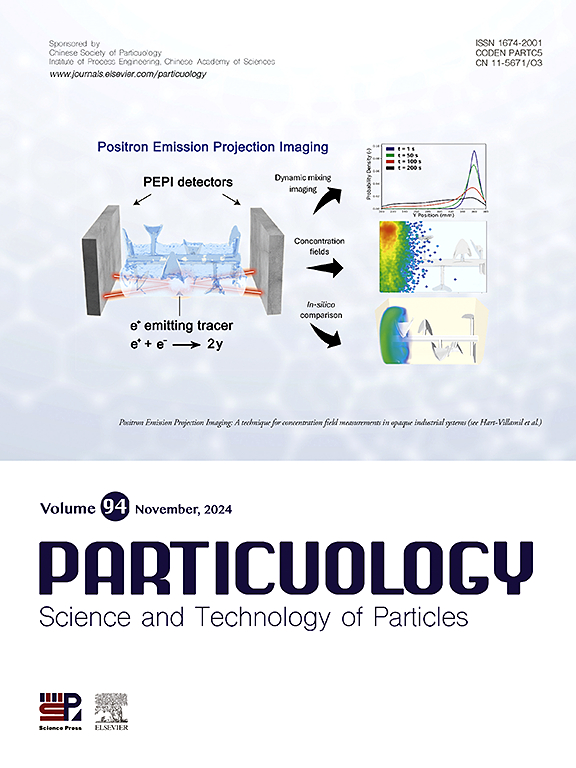Motion and force characteristics of wet particles in a fluidized bed
IF 4.1
2区 材料科学
Q2 ENGINEERING, CHEMICAL
引用次数: 0
Abstract
The presence of liquid alters the motion and force behaviors of wet particles compared to their dry counterparts. To investigate these differences, this study established a wet particle model using the discrete element method coupled with computational fluid dynamics. After validating the model, the fluidization behavior and force characteristics of wet particles as well as reactor wall erosion were examined, focusing on the effects of inlet gas velocity, initial liquid content, liquid film surface tension, and liquid film viscosity. The results reveal that the existence of the liquid film play an important role in particle dynamics within the bed. Higher liquid film surface tension typically enhances both the average liquid bridge force and the average inter-particle contact force. However, increasing liquid film viscosity generally strengthens the average liquid bridge force but reduces the average contact force. Additionally, the presence of a liquid film generally reduces the accumulated erosion volume of the reactor wall. These observations provide valuable insights into the motion and force behavior of wet particles in a fluidized bed.

流化床中湿颗粒的运动和力特性
与干燥颗粒相比,液体的存在改变了湿颗粒的运动和受力行为。为了研究这些差异,本研究采用离散元法结合计算流体力学建立了湿颗粒模型。在验证模型后,研究了湿颗粒的流态化行为和力特性以及反应器壁面侵蚀,重点研究了入口气体速度、初始液体含量、液膜表面张力和液膜粘度的影响。结果表明,液膜的存在对床层内颗粒动力学有重要影响。较高的液膜表面张力通常会增强平均液桥力和平均颗粒间接触力。然而,增加液膜粘度通常会增强平均液桥力,但会降低平均接触力。此外,液膜的存在通常会减少反应器壁的累积侵蚀体积。这些观察结果为流化床中湿颗粒的运动和受力行为提供了有价值的见解。
本文章由计算机程序翻译,如有差异,请以英文原文为准。
求助全文
约1分钟内获得全文
求助全文
来源期刊

Particuology
工程技术-材料科学:综合
CiteScore
6.70
自引率
2.90%
发文量
1730
审稿时长
32 days
期刊介绍:
The word ‘particuology’ was coined to parallel the discipline for the science and technology of particles.
Particuology is an interdisciplinary journal that publishes frontier research articles and critical reviews on the discovery, formulation and engineering of particulate materials, processes and systems. It especially welcomes contributions utilising advanced theoretical, modelling and measurement methods to enable the discovery and creation of new particulate materials, and the manufacturing of functional particulate-based products, such as sensors.
Papers are handled by Thematic Editors who oversee contributions from specific subject fields. These fields are classified into: Particle Synthesis and Modification; Particle Characterization and Measurement; Granular Systems and Bulk Solids Technology; Fluidization and Particle-Fluid Systems; Aerosols; and Applications of Particle Technology.
Key topics concerning the creation and processing of particulates include:
-Modelling and simulation of particle formation, collective behaviour of particles and systems for particle production over a broad spectrum of length scales
-Mining of experimental data for particle synthesis and surface properties to facilitate the creation of new materials and processes
-Particle design and preparation including controlled response and sensing functionalities in formation, delivery systems and biological systems, etc.
-Experimental and computational methods for visualization and analysis of particulate system.
These topics are broadly relevant to the production of materials, pharmaceuticals and food, and to the conversion of energy resources to fuels and protection of the environment.
 求助内容:
求助内容: 应助结果提醒方式:
应助结果提醒方式:


